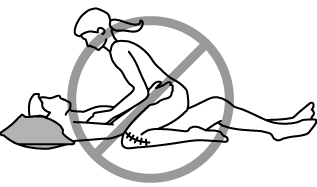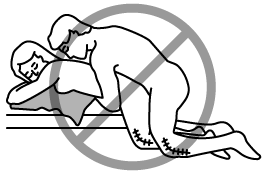When You’re Having a Knee Replacement
Activity Guidelines
Page Content
Movements to Avoid After Surgery
While you should increase your activities after surgery a little at a time, there are some movements you
should not do.
-
Don’t jar or twist your new knee suddenly. Make sure you don’t bend it in an uncontrolled way.
-
Don’t cross your legs.
-
Don’t sleep with a pillow under your knee. It can cause a permanent bend in your knee or put pressure on blood vessels in your leg.
Twisting and Turning
- Always keep your toes and your upper body facing the same direction.
- Take small steps when turning, instead of twisting or pivoting on your leg.
General Guidelines
The First 3 Months after Surgery
- Walking
- Phase 1 exercises
- Swimming and other pool exercises: Be careful not to do any twisting motions such as a knee kick. Don’t use the pool until incision is completely healed.
- Cycling: the seat must be set high enough so that you don’t have to bend your knee too much.
- Phase 2 exercises – start when your Case Manager or physiotherapist tells you to.
After 3 Months
- Low-impact fitness exercises that
don’t involve jumping, twisting, quick starts or stops, or other movements that put sudden force on your knee
- Walking on a treadmill and light hiking
- Cycling on a regular bicycle. Adjust the seat height as often as you need to let your knee bend comfortably
- Golfing
- Slow, gentle dancing
- Light hiking
- Gardening: Use raised beds or long-handled tools so you don’t kneel on your new knee.
Activities NOT to Do
- Do not lift and push heavy objects (25 lbs. or 11 kg)
- Do not do any activities involving jumping, twisting, quick starts or stops, or other movements that put sudden force on your knee
- Do not do contact sports
Sexual Positions
Many people have questions about intimate relations after a knee replacement. While it’s usually safe for your knee joint about 4 to 6 weeks after surgery, you also have to feel ready and be comfortable.
For the first 3 months you have to protect the new joint. These pictures show you the positions that are safe and the ones that aren’t safe for your new knee joint.
- Tell your partner what’s comfortable or if a position causes pain.
- Make sure you’re comfortable before you start. Using pillows may help.
- No sudden movements.
- Make sure your partner doesn’t put their full weight on your new knee joint.
Safe Positions for the Knee Joint
Positions Not Safe for the Knee Joint

Knee bends too much.

Too much pressure on knee.
*Illustrations from Returning to Sexual Activity following Joint Replacement Surgery (Vancouver Coastal Health, 2013) and Sex after Joint Replacement Surgery (London Health Sciences Centre, 2013)
Current as of: May 6, 2019
Author: Bone and Joint Health Strategic Clinical Network, Alberta Health Services
